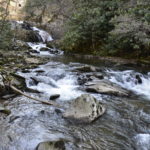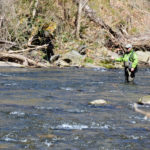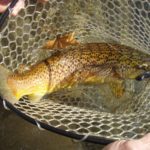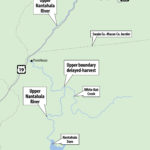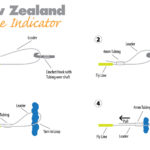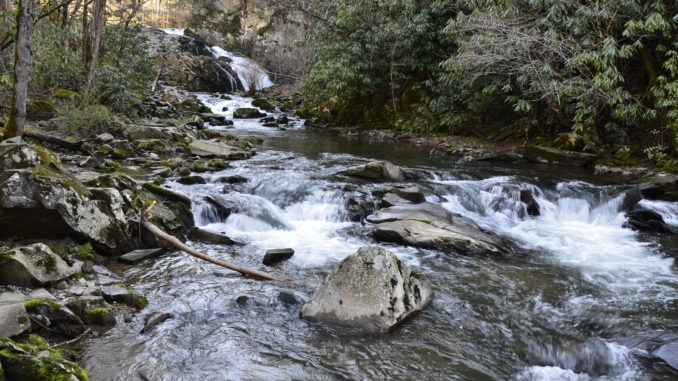
Keep your flies near the bottom and float them into a hungry trout’s mouth.
The Nantahala River in North Carolina’s southwestern corner has a well-deserved reputation for outstanding trout fishing having been listed among the country’s top 100 trout streams by Trout Unlimited.
One reason is that if offers different things to different fishermen. Much of the river is managed under hatchery supported, put-and-take regulations, but one section is famously managed under delayed-harvest regulations, which includes six months of catch-and-release fishing on a heavily stocked stretch of water.
The delayed-harvest section extends from the river’s junction with White Oak Creek downstream to the Duke Energy powerhouse the intersection of US 74/19 and Wayah Road. The river tumbles over boulders and cascades into pools. Trout linger in the calmest water, pockets where the boulders break the current or the pools.
This 4-mile section of the river receives an annual stocking of more than 18,000 trout, 40 percent of them brook trout, 40 percent rainbows and 20 percent browns. The heaviest stockings are March, April, May, October and November, with one smaller stocking in July.
By contrast, the 3-mile section of the river from the Duke Energy Powerhouse to the Swain County line, managed under hatchery supported regulations, receives an annual stocking of only 2,000 fish, and an 8-mile section from the Swain County line to Fontana Lake, also managed under hatchery supported regulations, gets only 5,000 fish.
Steve Banakas of Hayesville, a long-time trout fisherman and member of Trout Unlimited, described the river’s trout habitat: “The best spots include, of course, the deeper pools and some very calm pockets. My favorites are the areas just beyond the outside edges of the runs and where the runs play out. You should not overlook any of the quiet areas.”
Bob Martin of Rock Hill, S.C., who is active in the Federation of Fly Fishers, said, “Small waterfalls were everywhere. It was important to fish the flat steps and the sluices below the falls. I liked the pockets behind large rocks. I found trout hiding behind these in the eddy formed.”
Martin urged caution wading.
“Fish before you walk,” he said. “Several fish were in pockets along the side of the stream I was wading. The pockets were only 1 or 2 feet deep. I learned to fish these first before wading through.”
As far as tackle is concerned, Banakas uses a 9-foot, 5-weight rod and weight-forward line.
“I prefer a long rod because it enables you to reach over the runs, keeping much of the line off the water and fishing more drag free,” he said “I think best for winter nymph fishing is fluorocarbon leaders and tippet. I will use a 5X when on the Nantahala because of the size of many of the stocked fish. Fluorocarbon is more dense than monofilament and tends to sink faster.”
Martin recommends comparable gear, though he has resumed using bamboo fly rods because of their softer action.
Given the current and the rocks, a good wading staff is useful.
Banakas and Martin recommend fishing near the bottom and taking steps to get flies there.
“During the winter, the fish are usually way down near the bottom, and we’ve had pretty good success using heavily weighted flies, usually with tungsten beads to get the flies to the bottom fast,” said Banakas, a noted fly-tier. “The flies we use for weight are usually a rather large fly with a more realistic fly as the point. Occasionally, when the water is high, we attach one or two No. 4 pieces of lead (split) shot to the line. The most-important factor in winter fishing is to get the fly down to where the fish are.”
Martin agreed.
“In most places, you could never have too much weight,” he said. “I was using clam-shell weights, often three, four and six at a time. The current was frothy and fast. I couldn’t imagine a trout coming from behind a rock to chase a (No.) 20 nymph into the rapids.”
Banakas and Martin both fish nymphs under strike indicators. Cork, plastic bubbles or yarn indicators work.
“We have recently taken to using a New Zealand strike indicator system,” Banakas said. “It is very visible and seems to hold up just about anything you put under it. It does not crimp your tippet. And it can be moved up and down the tippet with ease.”
Banakas and Martin rely on popular patterns.
“Among the flies we use are large egg patterns, Y2K, Hare’s Ear, green and black woolly buggers about size 10 or 12,” Banakas said. “Dropped below them we use bead head flies in the 14 to 18 size range such as Pheasant Tail, Copper Johns, Tungsten Torpedoes, Iron Lotus, or flies of local origin like Glen Harker’s Glen’s BLT.”
Martin said, “Big sculpins and streamers worked. So did a variety of traditional nymphs.”
DESTINATION INFORMATION
WHERE TO GO/HOW TO GET THERE — The Nantahala River’s headwaters are the tailrace downstream from Nantahala Lake in Macon County. It flows into Swain County, where it widens and becomes an arm of Fontana Lake. The river is essentially a tailrace fishery, governed by water released through Nantahala Dam. The popular delayed-harvest section is between White Oak Creek and the Duke Energy powerhouse of US 19 and Wayah Road between Andrews and Bryson City. The best access is US 19.
TACKLE/TECHNIQUES — Fly-fishing tackle is the norm during delayed-harvest season (October until the first Saturday in June), because fishing is catch-and-release only, with single-hook, artificial lures. A 9-foot, 5-weight rod is about right to handle the sizes and requirements of the stream. Most of the winter fishing will be with nymphs, in Nos. 12-10, bead-head flies in Nos. 18-14, and sculpins and streamers.
FISHING INFO/GUIDES — Appalachian Outfitters, Murphy, 828-837-4165; Endless River Adventures, Bryson City, 800-224-7238, www.endlessriveradventures.com.
ACCOMMODATIONS — Bryson City-Swain County Chamber of Commerce, Bryson City, 800-867-9246, www.greatsmokiesfishing.com; Best Western, Murphy, 828-837-3060; Best Western, Dillsboro, 828-586-6060; Best Western, Waynesville, North Carolina 28786, 828-456-4402; Historic Calhoun Country Inn, Bryson City, 828-488-1234; Lloyd’s on the River, Bryson City, 828-488-3767; Almond Boat Park, Bryson City, 828-488-6423.
MAPS — Delorme’s North Carolina Atlas and Gazetteer, www.delorme.com; N.C. Wildlife Resources Commission, http://ncpaws.org/wrcmapbook/FishingAreas.aspx.
WHILE YOU’RE THERE — The Nantahala River is famous for whitewater rafting, and numerous outfitters offer guided trips, the best among them being Nantahala Outdoor Center, Bryson City, 828-785-5082, www.noc.com; and Endless River Adventures, Bryson City, 800-224-7238, www.endlessriveradventures.com.

